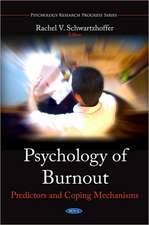Learning, Motivation, and Their Physiological Mechanisms
Editat de Neal E. Milleren Limba Engleză Paperback – 15 oct 2007
| Toate formatele și edițiile | Preț | Express |
|---|---|---|
| Paperback (1) | 449.41 lei 6-8 săpt. | |
| Taylor & Francis – 15 oct 2007 | 449.41 lei 6-8 săpt. | |
| Hardback (1) | 1000.27 lei 6-8 săpt. | |
| Taylor & Francis – 14 iul 2017 | 1000.27 lei 6-8 săpt. |
Preț: 449.41 lei
Nou
Puncte Express: 674
Preț estimativ în valută:
86.00€ • 89.24$ • 71.88£
86.00€ • 89.24$ • 71.88£
Carte tipărită la comandă
Livrare economică 17-31 martie
Preluare comenzi: 021 569.72.76
Specificații
ISBN-13: 9780202361437
ISBN-10: 0202361438
Pagini: 506
Ilustrații: 1
Dimensiuni: 152 x 229 x 29 mm
Greutate: 0.45 kg
Ediția:1
Editura: Taylor & Francis
Colecția Routledge
Locul publicării:Oxford, United Kingdom
ISBN-10: 0202361438
Pagini: 506
Ilustrații: 1
Dimensiuni: 152 x 229 x 29 mm
Greutate: 0.45 kg
Ediția:1
Editura: Taylor & Francis
Colecția Routledge
Locul publicării:Oxford, United Kingdom
Cuprins
Part VII: Learning; 22: The Perception of Children: A Genetic Study Employing the Critical Choice Delayed Reaction; 23: A Reply to “Sign-Gestalt or Conditioned Reflex?”; 24: Agitated Behavior of Rats During Experimental Extinction and a Curve of Spontaneous Recovery; 25: Integration of Neurophysiological and Behavioral Research; 26: Conflict Versus Consolidation of Memory Traces to Explain “Retrograde Amnesia” Produced by ECS; 27: A Brief Temporal Gradient of Retrograde Amnesia Independent of Situational Change; 28: Different Temporal Gradients of Retrograde Amnesia Produced by Carbon Dioxide Anesthesia and Electroconvulsive Shock; 29: Secondary Reinforcement in Rats as a Function of Information Value and Reliability of the Stimulus; 30: When Is a Reward Reinforcing? An Experimental Study of the Information Hypothesis; 31: Effect of Strength of Drive Determined by a New Technique for Appetitive Classical Conditioning of Rats; 32: Classically Conditioned Tongue-Licking and Operant Bar Pressing Recorded Simultaneously in the Rat; 33: Evidence for Positive Induction in Discrimination Learning; VIII: Physiological Basis of Motivation; 34: Mental and Behavioral Changes Following Male Hormone Treatment of Adult Castration, Hypogonadism, and Psychic Impotence; 35: Decreased “Hunger” but Increased Food Intake Resulting from Hypothalamic Lesions; 36: Hunger-Reducing Effects of Food by Stomach Fistula versus Food by Mouth Measured by a Consummatory Response; 37: Reward Effects of Food Via Stomach Fistula Compared with Those of Food Via Mouth; 38: Thirst-Reducing Effects of Water by Stomach Fistula vs. Water by Mouth Measured by Both a Consummatory and an Instrumental Response; 39: Learning and Performance Motivated by Direct Stimulation of the Brain; 40: A Technique for Mixing the Blood of Unanesthetized Rats; IX: Motivating Effects of Electrical Stimulation of the Brain; 41: Learning Motivated by Electrical Stimulation of the Brain; 42: Implications for Theories of Reinforcement; 43: Experiments on Motivation: Studies Combining Psychological, Physiological, and Pharmacological Techniques; 44: Rewarding and Punishing Effects from Stimulating the Same Place in the Rat’s Brain; 45: Motivational Effects of Brain Stimulation and Drugs; 46: Strength of Electrical Stimulation of Lateral Hypothalamus, Food Deprivation, and Tolerance for Quinine in Food; 47: Obesity from Eating Elicited by Daily Stimulation of Hypothalamus; 48: Lateral Hypothalamus: Learning of Food-Seeking Response Motivated by Electrical Stimulation; X: Chemical Coding of Motivation in the Brain; 49: Chemical Coding of Behavior in the Brain: Stimulating the Same Place in the Brain with Different Chemicals Can Elicit Different Types of Behavior; 50: Sensory Feedback in Time-Response of Drinking Elicited by Carbachol in Preoptic Area of Rat; 51: Saline Preference and Body Fluid Analyses in Rats after Intrahypothalamic Injections of Carbachol; 52: Pharmacological Tests for the Function of Hypothalamic Norepinephrine in Eating Behavior; 53: Unexpected Adrenergic Effect of Chlorpromazine: Eating Elicited by Injection into Rat Hypothalamus; XI: Instrumental Learning of Visceral Responses; 54: Modification of a Visceral Response, Salivation in Thirsty Dogs, by Instrumental Training with Water Reward; 55: Instrumental Learning of Heart Rate Changes in Curarized Rats: Shaping, and Specificity to Discriminative Stimulus; 56: Changes in Heart Rate Instrumentally Learned by Curarized Rats as Avoidance Responses; 57: Long Term Retention of Instrumentally Learned Heart-Rate Changes in the Curarized Rat; 58: Instrumental Learning by Curarized Rats of a Specific Visceral Response, Intestinal or Cardiac; 59: Instrumental Learning of Urine Formation by Rats; Changes in Renal Blood Flow; 60: Instrumental Learning of Vasomotor Responses by Rats: Learning to Respond Differentially in the Two Ears; 61: Instrumental Learning of Systolic Blood Pressure Responses by Curarized Rats: Dissociation of Cardiac and Vascular Changes; 62: Transfer of Instrumentally Learned Heart-Rate Changes from Curarized to Noncurarized State: Implications for a Mediational Hypothesis; 63: Heart-Rate Learning in the Noncurarized State, Transfer to the Curarized State, and Subsequent Retraining in the Noncurarized State; 64: Homeostasis and Reward: T-Maze Learning Induced by Manipulating Antidiuretic Hormone
Descriere
Neal E. Miller's pioneering work in experimental psychology has earned him worldwide respect. This second in a two-volume collection of his work brings together forty-three of Miller's most important and representative essays on learning, motivation, and their physiological mechanisms



















